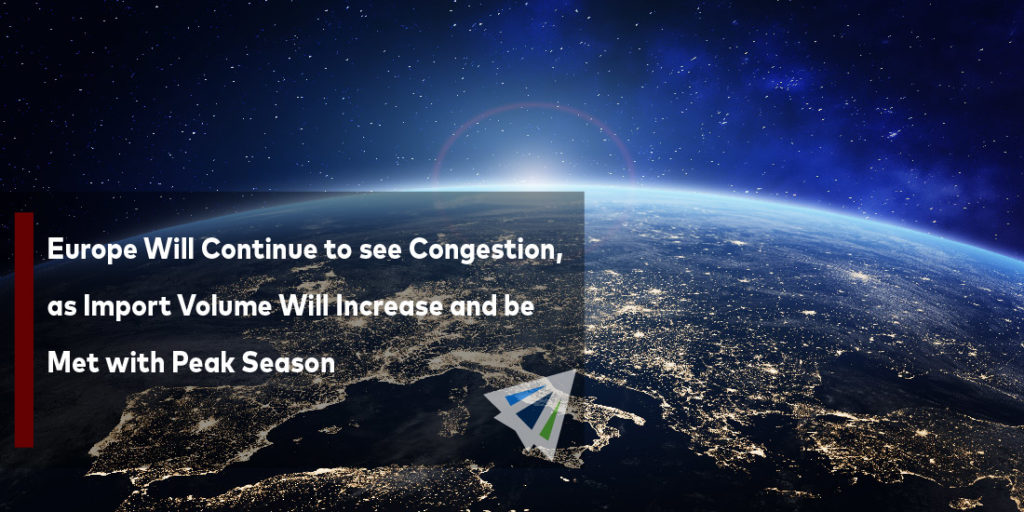Competitive Edge
June 22nd, 2022
Stay Current with Interlog’s Weekly Newsletter:
Headlines
- Last Thursday, President Biden signed into law the Ocean Shipping Reform Act of 2022 (OSRA-22). The new law gives maritime regulators increased oversight over container storage fees and supervision of ocean carriers and their adherence to rules on loading exports, the Journal of Commerce reports.
- This past Sunday morning, the world’s largest cargo ship arrived at the Port of Felixstowe in the U.K., where it is now in the process of unloading 3,267 containers. The Ever Ace holds the record for the most containers loaded onto a single ship. The vessel is capable of holding 23,992 standard containers, Hellenic reports.
UPDATE: U.S./Canada Ports – Number of Vessels at Anchor as of 06-21-22
- Savannah: 33 Vessels at Anchor (+7)
- New York/Newark: 16 Vessels at Anchor (-2)
- Houston: 16 Vessels at Anchor (+1)
- Vancouver: 15 Vessels at Anchor (0)
- Los Angeles/Long Beach: 13 Vessels at Anchor (+5)
- San Francisco/Oakland: 3 Vessels at Anchor (-5)
- Charleston: 1 Vessels at Anchor (0)
Note: This does not include vessels moored and being unloaded at port docks.
Courtesy: MarineTraffic
IMPORT: Asia to North America (TPEB)
Recent Developments:
- Shanghai has reopened after its two-month Covid-related lockdown. All businesses in the city have resumed work June 1, including manufacturing, production, and warehousing.
- From Triple Eagle (Group) Ltd., manufacturing and production in the city will take “some time” before returning to normal operations.
- Truck drivers will still need a Covid-negative NAT (nucleic acid test) report within 72 hours of gating in warehouses.
- Preventative measures, such as testing, are still strictly in place for accessing workplaces and using public transportation.
- With Shanghai opened up, many forecast a surge of pent-up demand will occur pressuring operations and increasing overall rates. However, as of now, it remains unclear to the exact strength of restoring volumes at the port.
- Contract negotiations between the International Longshore and Warehouse Union (ILWU) and Pacific Maritime Association (PMA) remain active. The existing labor contract between the two parties will expire July 1.
Rates: Rates remain relatively elevated compared to pre-pandemic levels but continue to fall. MSC plans to implement GRIs from Indian origins to U.S. destinations in July.
Space: Space is generally open for now, but any surges in demand and volumes will tighten space.
Capacity: Capacity has tightened in pockets. A certain trend of shippers shifting to the USEC has developed due to uncertainty around West Coast (ILWU and PMA) labor talks.
Equipment: Intermodal systems remain stressed with truck and chassis availability dire.
TIPS: Book at least 2-3 weeks prior to ready date. Strongly consider premium services and, if cargo is ready now, make plans to move as soon as possible with the current openings in space and fallen rates.
IMPORT: Europe to North America (TAWB)
Recent Developments:
- USWC ports have seen alleviated congestion and vast improvements to vessel waiting times.
- Port of Charleston continues its streak of minimal congestion. Only one vessel at anchor as of this week.
- However, not is all smooth for the USEC. Both Savannah and New York/Newark ports are experiencing significant congestion.
- On the Europe end, the Port of Hamburg has also experienced considerable congestion. The German port is also negotiating around current labor strikes from port employees.
- Recurring challenges with ocean freight has led to higher conversions to air freight among importers.
Rates: Rates remain elevated. What’s been seen in June will likely sustain into July.
Space: Space remains critical for USEC and USWC. However, there have been glimpses of improvements.
Capacity: Capacity for both North Europe and Mediterranean services remain gripped.
Equipment: Equipment remains generally available at European seaports. However, inland terminals in Europe are still reporting equipment shortages.
TIPS: Book 5 or more weeks prior to ready date. Shippers are strongly advised to use premium service for no-roll options and improved reliability for their cargo.
EXPORT: North America to Asia
Recent Developments:
- For the USEC, congestion remains considerable at New York-Newark and Savannah ports.
- Diminished schedule integrity continues to challenge post earliest return dates.
- Stifling vessel backlogs in Shanghai have led to increased occurrences of blank sailings.
- Vessel arrivals remain smooth for USWC POLs.
Rates: Some carriers have issued limited GRIs for June and into July.
Capacity: Available capacity remains fluid for USWC POLs.
Equipment: Truck, container, and chassis availability remain causes for concern and has significantly contributed to congestion of the intermodal system and IPI origins. Standard equipment at ports remains available.
TIPS: Book 4 to 5 weeks prior to time of departure to secure proper equipment and vessel space.
Did You Know: The Port of New Orleans will receive nearly $97 million in state funding to help with international trade and be prepared for growth in the future.
The funds will support expansion projects at the Napolean Avenue Container Terminal and the Jourdan Road Cold Storage Terminal, plus new transportation projects in Orleans and St. Bernard Parish.
Source: Container News
Freight News
The Port of Houston and the Port of Tacoma will receive funds from the USDA to help U.S. Agricultural Shippers
In an effort to ease port congestion and restore disrupted shipping services to U.S. grown agricultural commodities, the Port of Houston and the Port of Tacoma will receive funds from the U.S. Department of Agriculture, the American Journal of Transportation reported.
Within the partnership with the USDA, the Port of Houston will receive over 1,000 chassis, which will help the port utilize their full capacity for reefer containers. Since the port does not have a racking system – where refrigerated containers can be stacked and plugged in for power – it has to store their refrigerated containers on chassis, the Journal of Commerce reports. Chassis shortages have been an ongoing issue throughout this year.
Additionally, the Port of Tacoma exporters will receive incentives for using a “pop-up” yard to stage their shipments, the Journal of Commerce reported. The “pop-up” yard is 16-acres, which will help store reefer and dry container agricultural exports out of the terminals at NWSA’s Tacoma.
The USDA will also provide subsidies of $400 for reefer containers and $200 for dry containers, the JOC says. This is to help offset drayage costs for moving the cargo to the pop-up yard and then the second move to the Tacoma terminals.
U.S. imports from Asia rise to an unexpected record in May
Even after more than two months of lockdowns in Shanghai, U.S. imports from Asia rise to an unexpected record in May.
Specifically at the Port of Los Angeles, they handled 967,900 Twenty-Foot Equivalent Units (TEU) that month, which is their third best overall month in the Port’s history – Containers News reports.
Gene Seroka, Port of Los Angeles Executive Director, says American consumers have become more cost conscious, but overall demand remains strong. He continued to mention the productivity at the Port, where loaded imports in May this year reached nearly 500,000 TEU, after a 6.8% decrease the same time last year, reports show.
Furthermore, as the lockdowns occurred, some shipments originally scheduled from Shanghai exited different Chinese ports; Ningbo is a great example, as Ningbo exports saw a 25 percent increase, picking up the slack from Shangahi, the Journal of Commerce reports.
Blog Of The Week

Europe Will Continue to see Congestion, as Import Volume Will Increase and be Met with Peak Season
Watch last week's webinar!

We discussed import conditions, what the second half of summer looks like/what to expect, current events and had a live Q&A with our experts!
Sign up for our
industry answers
Our team works to provide valuable, unique, and relevant content to assist you in finding solutions. Sign up now.